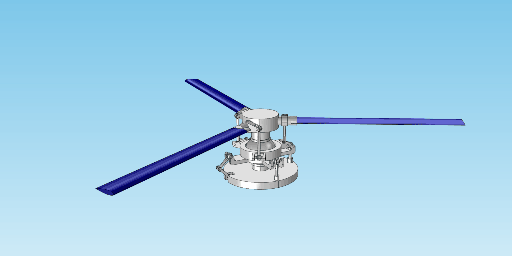Talking about helicopters in general. They use different surfaces to help the device turn, but essentially the helicopter only needs the rotor blades, in Portuguese called rotating wings, to make the turns. Even in the most conventional helicopters, the main function of the tail rotor is to simply counterbalance the torque generated by the main rotor, it is simply not necessary to perform turns (although it can be used to assist in the turn and increase the maneuverability of the helicopter). , aggregated with other factors)
There’s no way to explain this better without going into detail, which will make the post long, but I hope it’s really worth reading.
History
Historically, building a functional helicopter was a difficult task with designers having to solve several problems, one of which was called lift asymmetry (at least in Portuguese)
To explain this concept, let me make some drawings, imagine the helicopter flying forward like this

considering the speeds in relation to the ground as: VR the rotation speed of the rotor blades, VL the linear speed of the heli, and VW the wind speed.
When the helicopter makes this movement of flying forward, note that observing the rotational movement, the blades that ‘advance’ forward have a higher relative wind speed than the blades that retreat backwards

in other words, the purple blade will have a higher relative speed with the wind than the green blade. This will cause a ‘lift asymmetry’ with the purple blade generating more lift than the green one, simply due to the natural movement of the helicopter.
and this was one of the main problems that helicopter designers faced, because, at the beginning of the helicopter, it tended to be unstable and make this type of downward movement(on image below), rotating in the direction that had less lift, for obvious reasons (it would be as if If a plane was missing one of its wings.)

and to solve this, for a long time many helicopters adopted rotors like this, just like this German one before the Second World War(image below)

This problem was only actually solved by the Italian Juan de la Cierva when he designed one of his known autogyros.
Basically, Juan made a mechanical mechanism that allowed the main rotor blades to have different movements, such as going up and down due to elasticity; have an advance and a retreat; Furthermore, it is possible to change the angle of attack of the rotor blades. As indicated in the gifs below in a simpler way


then the lift asymmetry was corrected by changing the angle of attack and the inclination of the rotor blade, correcting the lift and making the helicopter have a much more stable flight.
Nowadays this mechanism is called collective pitch and ciclical control. And in war thunder we control part of this by changing the coil and using the mouse (another part the game itself does for us, as war thunder is not a helicopter simulator.)
How is this related to the subject?
So, having said all of the above, in real life, for a helicopter to ‘climb’, it does not change the engine torque as many people think (it could do this but it is an extremely imprecise method). It only increases the angle of attack of the rotor blades, generating more lift and thus rising. In the same way, for a helicopter to go forward or sideways, it simply needs to control the lift on the side it wants to go. In the forward case, it is enough to make the rotor blades generate less lift in the front than in the back, tilting the helicopter forward and causing it to move forward.
This is the main way a helicopter makes turns too, it makes these lift changes to the side it wants to turn and makes the turn. the general fuselage of the helicopter just follows the air flow, rotating due to less aerodynamic resistance
And of course, when it is actually stopped, static in the air, it uses the tail rotor to perform this function and rotate the helicopter. In the case of the ka-50, it makes a difference in rotation between the rotors, generating torque to where you want to go, but again, this is a less efficient method than when it is in motion, as it makes less use of this lift generated by the rotors. in war thunder, you can actually test this and see that the helicopter in general has more difficulty doing 360 degrees when stationary than when it is moving.
but effectively, an helicopter does not need a tail rotor, or a tail rotor, or anything else to make turns, it can make turns just using the rotor blades. This is why in Portuguese we call helicopters ‘rotary-wing aircraft’ because the helicopter rotor and its blades function exactly like wings, being able to change angles of attack and, in some cases, even having flaps in the middle of the ‘wing’, like can be seen in the image below.

I hope I have added knowledge.









